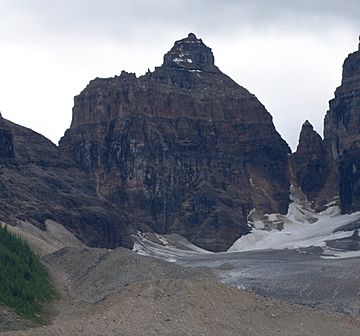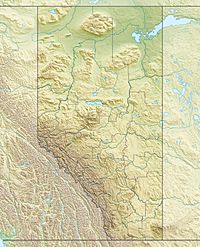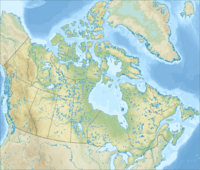The Mitre (Alberta) facts for kids
Quick facts for kids The Mitre |
|
|---|---|

The Mitre and Lefroy Glacier
|
|
| Highest point | |
| Elevation | 2,850 m (9,350 ft) |
| Prominence | 229 m (751 ft) |
| Parent peak | Mount Lefroy (3423 m) |
| Listing | Mountains of Alberta |
| Geography | |
| Location | Alberta, Canada |
| Parent range | Bow Range |
| Topo map | NTS 82N/08 |
| Geology | |
| Age of rock | Cambrian |
| Type of rock | Sedimentary rock |
| Climbing | |
| First ascent | 1901 C. Kaufmann; J. Pollinger; G. Collier; E. Tewes; G. Bohren |
The Mitre is a cool mountain peak that stands tall at 2,850 meters (about 9,350 feet). You can find it in the beautiful Lake Louise area of Banff National Park, which is in the Canadian Rockies of Alberta, Canada. It's part of a group of amazing mountains!
The Mitre is close to some other big peaks. Its closest taller neighbor is Mount Lefroy, which is about 1.0 kilometer (0.6 miles) to the west. Another mountain, Mount Aberdeen, is about 2.0 kilometers (1.2 miles) to the north-northeast. You'll also find the Lefroy Glacier just north of The Mitre, and the Mitre Glacier to its southwest. To the southeast, there's a lovely area called Paradise Valley.
Contents
Why is it called The Mitre?
The mountain got its name, The Mitre, in 1893 from a person named Samuel E.S. Allen. He probably named it this because the mountain's shape looks a lot like a Bishop's mitre. A mitre is a special, tall hat that bishops wear.
Who climbed The Mitre first?
The very first time someone successfully climbed to the top of The Mitre was in 1901. A group of climbers made this amazing achievement: Christian Kaufmann, J. Pollinger, G. Collier, E. Tewes, and G. Bohren.
The name "The Mitre" was officially recognized and adopted in 1952 by the Geographical Names Board of Canada.
What is The Mitre made of?
Just like other mountains in Banff National Park, The Mitre is made up of a type of rock called sedimentary rock. This kind of rock forms over a very long time from layers of sand, mud, and tiny bits of other rocks that settle at the bottom of ancient seas.
These layers of rock were laid down during periods in Earth's history called the Precambrian and Jurassic periods. Later, during a huge event called the Laramide orogeny (say: lah-rah-mide or-OJ-uh-nee), these rocks were pushed up and over younger rocks, creating the mountains we see today!
What's the weather like at The Mitre?
The Mitre is located in a subarctic climate zone. This means it has very cold and snowy winters, but its summers are usually mild. Temperatures can often drop below −20 °C (which is −4 °F), and with the wind blowing, it can feel even colder, sometimes below −30 °C (−22 °F)! So, it's a chilly place in winter!



